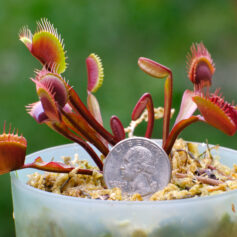Description
NORTHERN PITCHER PLANT
Northern pitcher plant (Sarracenia purpurea subsp. purpurea) is a crazy-cool carnivorous plant that’s easy to grow and endlessly rewarding … unless you’re an insect. Its leaves have evolved into tubular pitchers that collect water which, in turn, capture flies and other unsuspecting visitors. Pitcher plants make the perfect centerpiece for container bogs and associate well with bog orchids, Venus flytraps, and other such plants. (see Associates below)
HABIT
Northern pitcher plant forms a rosette of tubular leaves—the pitchers—which can be up to eight inches long. The pitchers vary in color from green to red with contrasting veins that can be quite attractive. In early summer, mature plants produce a flower stalk, up to 20 inches high, which carries a single nodding flower.
HABITAT
Northern pitcher plant is an obligate wetland plant, meaning it almost always grows in wetland areas. Its primary habitat is Sphagnum bogs, but it may be found in other wet acidic places as well. In at least some parts of its range, it grows in calcareous areas, like fens. The primary habitat requirement seems to be low nutrition.
ETYMOLOGY
The genus name (Sarracenia) is derived from Michael Sarrazin, a physician born in France in 1659, who was the first to suggest pitcher plants devour insects.
The species name (purpurea) is a reference to the dark purple of the leaves.
The common name is a reference to the pitcher-shaped leaves. Other names include Purple Pitcherplant, Northern Pitcher-plant, Northern Purple Pitcherplant, Indian Dipper, Huntsman’s Cup, Adam’s-Pitcher, Dumb-watch, Frog’s Britches, and Whippoorwill-boots. The plant is also known as Side-saddle Flower or Sidesaddle Plant, a reference to the under part of the flower said to be somewhat like the seat of a sidesaddle. Several other names (Fever-cup and Smallpox-plant) refer to the plant’s purported medicinal properties.
— Adirondacks Forever Wild.
RANGE
Two subspecies of northern pitcher plant are generally recognized today—Sarracenia purpurea subsp. purpurea to the north, and Sarracenia purpurea subsp. venosa to the south. We currently offer the northern subspecies that is native the eastern seaboard of the United States, the Great Lakes, and southeastern Canada. At the southern end of its range it intergrades with the southern subspecies and botanists argue over its presence, at high elevations, as far south as North Carolina. For an even deep dive, checkout the Carnivorous Plant FAQ.
ASSOCIATES
Northern pitcher plant associates with other bog denizens, including roundleaf and spoonleaf sundews, grass pink orchids, rose Pogonia, and Venus flytraps.
NOTES
We have plenty of small plants in stock and anticipate releasing some specimen-size plants this fall. If you’re interested in the latter, check back in October or join our email list to receive notification. All our pitcher plants are seed-grown from our nursery collection.
** Small plants have several immature pitchers and may produce one or more mature pitchers during the next growing season.
** Medium plants have several immature pitchers, one or more mature pitchers, and may produce attentional mature pitchers during the next growing season.
** Large plants have two or more mature pitchers and may produce flowers during the next growing season.




